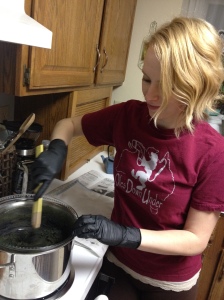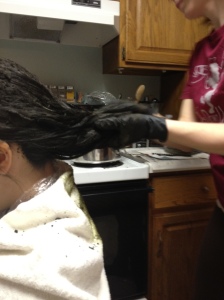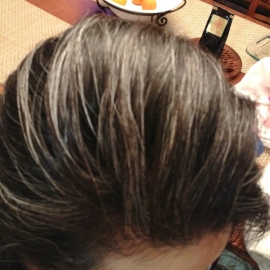It’s no secret that I have gray hair. I started getting flecks of gray when I was about 16, and every year thereafter I sprouted more. I didn’t realize how gray my hair had become until I looked at an up close shot of my head the other night. (I included the photo below). Wow! For those of you who see me every day maybe this isn’t news, but it was somehow news to me, and I see myself every day. Makes me wonder what else I am not noticing about myself on a regular basis…
Anyway, as you know, I try to be as natural as I can be when it comes to my lifestyle and that applies to beauty products as well, and it’s not easy. Often times I go without more than I find myself discovering safe and healthy products. For me, going more natural does not always go hand in hand with a beauty/self-care routine that works. I’m still definitely in the testing phase, and let’s just say over the past year, I’ve cracked eggs on my head, gone without shampoo, poured coffee into my hair, created oatmeal exfoliators, etc., etc.! Some of these beauty remedies have had more success than others. All have been fun to try.
Henna dye is another to add to my list. This past weekend my friend and hair enthusiast, Colleen came over to my house with a block of henna. Our goal was to see if we could use it to cover some of my gray. Colleen picked up the dye from Lush. We both had no expectations. Our only thoughts we had were based on the little reading we did, so we figured it may smell like cow manure and it was probably going to be very messy. To a degree we were right on both accounts.
Before going on, let it be known that just because henna is a natural product does not mean that there are no implications with using the product. There are pros and cons to using henna. One of the cons is that henna is a permanent hair dye and it reacts with your current hair, so there is no guarantee on what color it will look like and you cannot simply go over to a local hair salon to “fix” your dye experiment if it goes wrong. (Beware to those who already have colored your hair as there can be problems). I’m lucky that we didn’t have any big surprises, especially since I need to take a photo for my work badge in a couple days.
Below are the pictures that tell the story.
1. The goods: 1 block of henna, vaseline for the hairline (does the petroleum cancel out the goodness of henna’s natural properties? nah! If you are a purist, Lush does sell a product that does the same job), comb, not pictured: gloves, hair clips, towel, saran wrap, tarp to cover your workspace.
2. The mixing process: Chop block up into thirds with a knife and cutting board. Place in a heat-resistant glass bowl. Cover with boiling water (from teapot). Break it up and mix it with a wooden utensil. We used a paint stick. Lush recommends a wooden spoon. Mix until it’s the consistency of yogurt or brownie batter. To keep it warm, place bowl over hot water (on low). See photos below.
 Don’t be surprised if you smell something weird. We still haven’t figured out how to describe the smell. It was not cow manure, but two different people stopped by while in the process and both immediately commented on the weird smell in the house. One said, “rotting compost”, but we all have not come to an agreement on how to describe the smell.
Don’t be surprised if you smell something weird. We still haven’t figured out how to describe the smell. It was not cow manure, but two different people stopped by while in the process and both immediately commented on the weird smell in the house. One said, “rotting compost”, but we all have not come to an agreement on how to describe the smell.
 Colleen adding a little more water to the mix.
Colleen adding a little more water to the mix.
3. The application process: Clip up the hair in sections. Make sure you are wearing gloves, and work the henna into the hair starting from the bottom of the head moving your way up. (Keep adding water as you need – we found the henna dries up fast).
4. Wrap it up! Once you have the whole head covered, wrap the head in saran wrap (to keep it moist) and then a plastic bag (for extra support). You could be cuter with it if you had to go out in public and use a scarf as a head wrap. I was fine with the plastic bag look since I had nowhere to go.
5. Wait and wash, wash, and did I say wash? The packaging says to wait 1-2 hours. We waited for 1.5 hours. Some people leave it in overnight. It’s hard to say if we waited any longer if we would have seen different results. I may try to wait it out a couple hours longer my next try. And with the washing, just be ready to clean up a mess in your tub!
6. Results: The photos don’t do a great job of showing the results because when we took the first photo we were in daylight and the second photo it was dark and my hair was very shiny reflecting more light on the camera lens. I am still unsure how to describe the results, I would say a lot of the gray is still there, but my hair looks more blended overall. I think there is a brownish hue to my hair and it lightened it a bit which would be contrary to the “blue-black” color I used. I am curious if part of this was a reaction to previous chemicals in my hair. It’s hard to tell because wherever there was gray there were no chemicals. Will be interested in asking staff at Lush.
BEFORE
AFTER
Overall, like some other people’s experiences, I was unable to get full gray coverage. I definitely had a reduction in gray and an overall more uniform hair color, but a significant amount of grays are still there. My husband thinks the grays look darker, and he would probably know better than I would considering a night ago I didn’t even realize how much gray hair I had 🙂
I will keep you posted on round 2 if I see different results. I am not discouraged enough yet to throw in the towel. I am a little nervous because I am a bridesmaid in a wedding coming up end of May and didn’t consider the implications of not being able to go to a hairdresser if henna doesn’t work. Regardless I am considering making a stop at Lush to set up an appointment with them sometime late April. Apparently they will do a free application of the product if you schedule ahead. I know this will save Colleen and my kitchen from a future mess. I will keep you posted on the results!
If you want to read more in depth about henna and it’s benefits, check out this helpful article.








